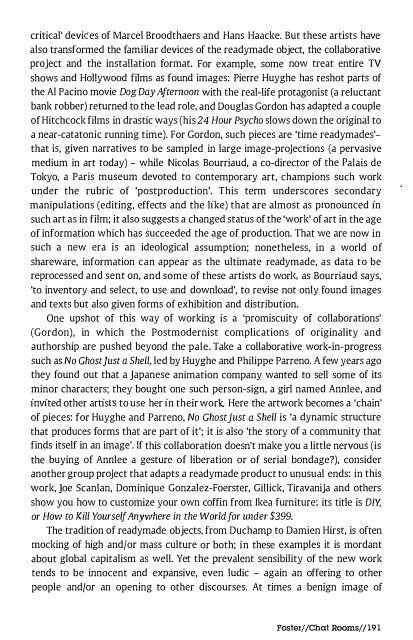You also want an ePaper? Increase the reach of your titles
YUMPU automatically turns print PDFs into web optimized ePapers that Google loves.
critical' deviCes of Marcel Broodthaers and Hans Haacke. But these artists have<br />
also transformed the familiar devices of the readymade object, the collaborative<br />
project and the installation format. For example, some now treat entire TV<br />
shows and Hollywood films as found images: Pierre Huyghe has reshot parts of<br />
the Al Pacino movie Dog Day Afternoon with the real-life protagonist (a reluctant<br />
bank robber) returned to the lead role, and Douglas Gordon has adapted a couple<br />
of Hitchcock films in drastic ways (his 24 Hour Psycho slows down the original to<br />
a near-catatonic running time). For Gordon, such pieces are 'time readymades'that<br />
is, given narratives to be sampled in large image-projections (a pervasive<br />
medium in art today) - while Nicolas Bourriaud, a co-director of the Palais de<br />
Tokyo, a Paris museum devoted to contemporary art, champions such work<br />
under the rubric of 'postproduction'. This term underscores secondary<br />
manipulations (editing, effects and the like) that are almost as pmnounced in<br />
such art as in film: it also suggests a changed status of the 'work' of art in the age<br />
of information which has succeeded the age of production. That we are now in<br />
such a new era is an ideological assumption: nonetheless, in a world of<br />
shareware, information can appear as the ultimate readymade, as data to be<br />
reprocessed and sent on, and some of these artists do worl� as Bourriaud says,<br />
'to inventory and select, to use and download', to revise not only found images<br />
and texts but also given forms of exhibition and distribution.<br />
One upshot of this way of working is a 'promiscuity of collaborations'<br />
(Gordon), in which the Postmodernist complications of originality and<br />
authorship are pushed beyond the pale. Take a collaborative work-in-progress<br />
such as No Ghost}ust a Shell, led by Huyghe and Philippe Parreno. A few years ago<br />
they found out that a Japanese animation company wanted to sell some of its<br />
minor characters: they bought one such person-sign, a girl named Annlee, and<br />
invited other artists to use her in their work Here the artwork becomes a 'chain'<br />
of pieces: for Huyghe and Parreno, No Ghostjust a Shell is 'a dynamic structure<br />
that produces forms that are part of it': it is also 'the story of a community that<br />
finds itself in an image'. If this collaboration doesn't make you a little nervous (is<br />
the buying of Annlee a gesture of liberation or of serial bondage?), consider<br />
another group project that adapts a readymade product to unusual ends: in this<br />
work, Joe Scanlan, Dominique Gonzalez-Foerster, Gillick, Tiravanija and others<br />
show you how to customize your own coffin from Ikea furniture: its title is DIY,<br />
or How to Kill Yourself Anywhere in the World for under $399.<br />
The tradition of readymade objects, from Duchamp to Damien Hirst, is often<br />
mocking of high and/or mass culture or both: in these examples it is mordant<br />
about global capitalism as well. Yet the prevalent sensibility of the new work<br />
tends to be innocent and expansive, even ludic - again an offering to other<br />
people and/or an opening to other discourses. At times a benign image of<br />
Posterl/Chat Rooms! /191








